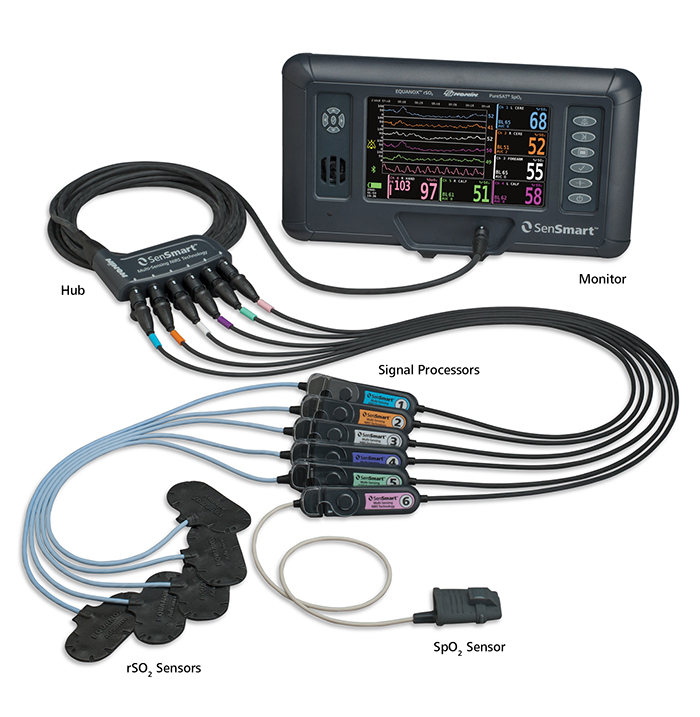|
From a portable monitor to smaller signal processors to interchangeable rSO2 and SpO2 sensors, the SenSmart System brings new possibilities that support your decision-making process today, and provides a platform for adding more parameters in the future.

|
Signal Processors
- Smaller (33 cc) and less bulky (40 g/1.4 oz) signal processors are easy to work around, easy to move around and will not get in your way. Ideal for use in a variety of settings including neonatal incubators and minimum space-on-bed situations.
- Fast start-up and fast signal acquisition deliver readings in seconds. Turn the system on and start monitoring.
- Easy to use, the color-coded and numbered universal signal processors connect to any of the six hub ports. Channels will display properly without any need to connect to the hub in any certain order.
- Sensor-lock eliminates disconnections.
rSO2 Sensors
- Flexible sensors conform easily to patient anatomy.
- Adhesive and non-adhesive options for neonate/infant/pediatric patients.
- Center orientation of the rSO2 sensor cables allows for directing cables over the patient’s forehead, preventing sideways torquing on the sensor cable or pressure against skin surfaces with sideways movement of the head.
- Immune to the effects of ambient light; no need to cover the exposed sensor and surrounding skin with a light-shielding drape.
- Skin color or pigmentation has not been shown to affect the accuracy of the readings.
SpO2 Sensors
- High-intensity pure light spectrum eliminates variations in readings from patient-to-patient and sensor-to-sensor.
- Fast, accurate SpO2 readings.
- Reusable with a durable design and comfortable fit for continuous monitoring.
- Form fitted to decrease ambient light interference.
- Available in three patient sizes.
Monitor
- Color-coded display automatically recognizes and displays signal processor channel number, oximetry type (rSO2 and/or SpO2), and lets you select or customize display of sensor site per channel. In multi-sensor situations you can quickly identify which sensor is which channel, so you can focus on the patient, not the monitoring system.
- Intuitive, easy-to-operate user interface includes optional patient I.D. capability, as well as the ability to scroll back in the case and/or instantly retrieve a table of event values recorded.
- Weight advantage: 900 g (2 lbs) versus the 6.85 kg (14 lbs) of other regional oximetry systems currently on the market.
- Up to 10 customizable presets allow quick start, even when departments or individual clinicians have unique preferences. A major advancement for clinicians dissatisfied with "one-configuration-fits-all".
- Easy-to-read, configurable trend lines (rSO2) and plethysmography displays (SpO2) for a quick visual reference.
- Data transport to electronic medical record (EMR) systems via the hospital’s interface engines.
- Long battery life (three hours when operating with two channels) makes it suitable for easy transport in and outside of the hospital.
- Up to 840 hours of data memory and SenSmart™ Download Software for case analysis, record keeping or research. State-of-the-art Bluetooth® wireless connectivity allows you to download cases without a connecting cable.
- Designed to work with the Philips® IntelliBridge® interface and Philips IntelliVue® patient monitors to provide parameter and trend line display.
- Display can operate in eight different languages.
Cables
- 4-meter hub cables allow flexibility in system placement; plus 1- or 2-meter signal processor extension cables increase range when needed.
- Thin, durable sensor cables shielded from ambient electronic signals; ideal for use in a variety of settings including OR, ICU, Electrophysiology and NICU.
|
|
| |
|